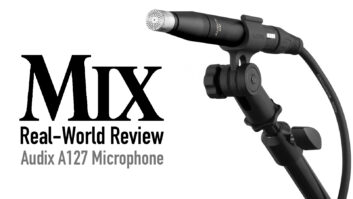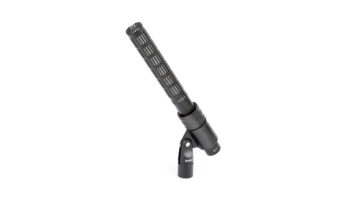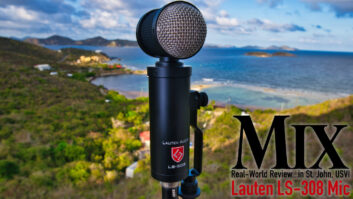Electret shotgun microphones—such as beyerdynamic’s MCE 86 II ($379 street), reviewed here—are small diaphragm condensers, yet ones with key design features, making them the only choice for some recording and sound reinforcement tasks. Live events (from sports to outdoor weddings), theaters and houses-of-worship (HOWs) are distinctly different environments where one or two available shotgun microphones can make the difference between sound success and a noisy disaster, as they will capture slightly-to-fairly-distant sounds like no other microphone type on the market.
How do they work? Well, a standard shotgun microphone most always features a long, multi-slotted tube paired with a supercardioid or hypercardioid capsule beneath it. In use, the desirable on-axis sound reaches the capsule and off-axis sound largely cancels itself out first as it enters the mic’s multiple side slots, thus essentially “enhancing” the on-axis sound.
I’ve personally discovered several great uses for these “interference tube” microphones in places such as small- to medium-sized HOWs. Two areas in which a shotgun microphone will shine include where pastors want their own microphone out of sight (a shotgun can easily be placed multiple feet away, near the floor and hidden in a flower arrangement, for example) rather than an obtrusive podium mic; and, for example, in theatrical productions, holiday pageants, etc., where multiple children have speaking parts and there aren’t enough inputs or microphones (or both) to capture everyone. In the latter example, simply grab a shotgun microphone and boom pole then actively aim it, or “run and gun.”
The MCE 86 II is an affordable and truly superb-sounding hypercardioid shotgun, one I would enthusiastically recommend to anyone. It sounds fabulous and full-range, boasting a rich 50 Hz-18 kHz frequency response. It’s lightweight for its size (0.2 lbs.), ruggedly built with a work-ready, no-scratch finish.
In reviewing the MCE 86 II, it performed flawlessly for such HOW tasks detailed above. I left the mic at a local church to use for a couple of weeks; they responded by enthusiastically inquiring about where to buy one. For years, their revolving volunteer staff tried to capture small youthful voices in various plays as well as the shy and public-speaking averse; now they finally had an easy-to-use and unobtrusive tool to capture them.
Next, I was hired to provide comprehensive sound services for a summertime outdoor wedding—from live band reinforcement and playback to capturing the vows for recording and sound reinforcement purposes. For this gig, the MCE 86 II was the linchpin; during dress rehearsal I auditioned the shotgun, pointing it precisely where the bride and groom stood with the pastor. The result was an intimate, close-up spoken word track that proved to be both useful during the wedding as well as later, when pairing with a wedding video shot by another party.
Finally, I just happened to have the MCE 86 II in my microphone bag while running sound for a multi-artist outdoor acoustic/bluegrass event. This being a “gather ’round the mic”-type of setting, there were two different instances during the event where one particular instrumentalist was hard to hear in the overall mix. Just as an experiment, I grabbed the MCE 86 II, put it on a stand and placed it as out of sight as I could, being careful to aim toward the “buried” player. It worked like a charm, especially during solo passages where the player needed just a small yet natural sounding boost.
The MCE 86 II’s remarkable smoothness rivals small diaphragm condensers I’d normally choose to use in the studio, and I believe that’s saying a lot—especially considering its affordable price. A shotgun microphone is simply a tool worth having in any “workhorse” microphone collection, and the MCE 86 II is an ideal specimen.
beyerdynamic
http://north-america.beyerdynamic.com







